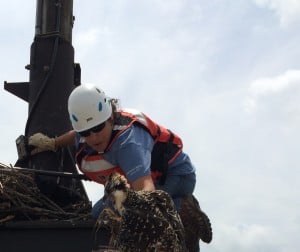Share this article
Ospreys recover in Chesapeake despite pollutants
The Chesapeake Bay is now home to around 10,000 mating pairs of ospreys despite constant levels of some chemical pollutants in the water.
“The osprey population in the Chesapeake is really at an all-time high,” said Barnett Rattner, an ecotoxicologist with the U.S. Geological Survey and co-author of a recent study published in Environmental Toxicology and Chemistry. “Things aren’t perfect but they are much better.”
The researchers monitored osprey (Pandion haliaetus) nests in seven to 10-day intervals from late March through the end of July from 2011 through 2013 in regions of concern like the Anacostia, Potomac and Patapsco Rivers and the Baltimore Harbor. They collected and chemically analyzed egg samples and looked for genetic damage in blood samples taken from osprey chicks. They also counted how many osprey chicks hatched and how many fledged, and took samples from the fish the hawks eat.
“We follow the fate of those sampled nests very carefully,” said Rattner, a member of The Wildlife Society.

USGS researcher Rebecca Lazarus prepares to take a blood sample from an osprey fledgling in a nest on the Chesapeake and Delaware Canal, Delaware Bay in 2015. ©USGS
He said DDT levels had “wreaked a lot of havoc” on osprey in previous decades — by 1972 when the chemical was banned, the population in the Chesapeake was down to 1,500 mating pairs. But the concentrations the researchers found in egg samples were a lot lower compared to previous years.
PCBs were brought in to replace DDT but were also banned in 1979. Despite this, Rattner says that the levels of these newer chemicals have stayed constant since then in the bay.
“In fact the levels of PCBs have not changed significantly in the past 35 years, which tells you how persistent these chemicals are,” said Rattner in a release. “Yet the birds are doing well. They’re exposed to these toxic chemicals, which are biomagnified up the food chain, yet fortunately we do not see any really serious effects in ospreys.”
He also says that levels of PBDEs, a chemical found commonly in flame retardants, have increased by about 40 percent since 2000-2001.
“We learned that PBDE flame retardants are biomagnified up the food chain (fish to osprey) in Chesapeake Bay by a factor of about 20 to 30 times,” Rattner said. “But there was no evidence of impaired hatching success in Chesapeake Bay ospreys.”
Rattner said the researchers also found other “good news.” They tested for 23 different pharmaceutical compounds and an artificial sweetener present in the bay through wastewater but found that the levels present in the birds weren’t high enough to cause detectable problems for the ospreys.
“Some of it passes through them. Most of it isn’t detectable,” Rattner said.
Header Image: Osprey chicks in a nest on the James River in Virginia. ©Rebecca Lazarus, USGS








